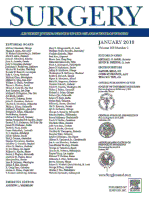Adler RH, Firme CN, Lanigan JM
Surgery. 1958;44:63-75.
Adler RH, Firme CN, Lanigan JM. A valve mechanism to prevent gastroesophageal reflux and esophagitis. Surgery. 1958;44:63-75.
After searches in PubMed.gov, Amazon.com and AbeBooks.com we were unable to locate a digital copy of this peer-reviewed clinical publication. This material may be protected by copyright law.
It is our intent to honor Drs Richard H Adler, Constante N Firme, and John M. Lanigan’s work by highlighting the introduction and summary from this fundamental text. In it, the doctors were invited to describe a 2-part study that included human cadavers and live dogs.
A Valve Mechanism to Prevent Gastroesophageal Reflux and Esophagitis
The cardioesophageal area is normally competent in preventing reflux of gastric secretions into the esophagus when the stomach is maintained in its normal position below the diaphragm with the terminal esophagus bordered by a snugly fitting diaphragmatic hiatus. The incompetence associated with a sliding hiatal hernia is automatically corrected when the now fairly standardized methods for replacing the stomach below the diaphragm and correcting the hiatal defect are applied. Unfortunately, it may not be possible to restore this normal anatomic arrangement when the esophagus is short, fibrosed, or strictured, or when plastic and excisional surgery of the distal esophagus and cardia are performed.
When the cardia remains above the diaphragm, a situation resembling a hiatal hernia with incompetence results. It has only recently been appreciated that reflux esophagitis and its disabling complications are common sequelae. The problem that presents, therefore, is how to establish continuity between the shortened esophagus and stomach in a way that will prevent gastroesophageal reflux and esophagitis. Some of the experimental and clinical operative procedures designed to prevent reflux esophagitis may be listed as follows: interposition of a segment of jejunum or colon between esophagus and stomach, extensive esophagectomy and high esophagogastrostomy, various forms of gastric resections, gastric drainage procedures and vagotomy used alone or in combination, advancing the shortened esophagus from the hiatus to the dome of the diaphragm, reconstitution of the cardioespohageal angle, and construction of cardioesophageal “valves.”
With this problem in mind, the present study was undertaken in an effort to find a simple procedure for maintaining a competent esophagogastric union independent of its position in relation to the diaphragm. A lead was taken by recalling that certain other tubular structures such as ureter and common bile but have an oblique course through the muscular wall before entering their hollow distensible viscera. Although we found it possible to create a tunnel for the esophagus between the muscular and mucosal layers in specimens of human and dog stomachs, the disproportions in size between the esophagus and stomach wall plus the bulkier contents transported through the esophagus made this approach appear to be less attractive. Instead, the principle used in the Witzel enterostomy was modified by burying the terminal esophagus in a loose tunnel formed from the redundant fundus. The problem was also approached by partially encircling the terminal esophagus with a sling of knotted nylon net which was sutured back onto both surfaces of the fundus. Our experiences with these methods and their modifications in dogs will be presented in this paper, along with pertinent observations on human and canine specimens of stomach and esophagus.
Summary
1. A simple method of making a one-way cardioesophageal valve independent of the diaphragm is described. This mechanism permits normal swallowing but prevents gastric reflux into the esophagus.
2. Pertinent studies on human stomach and esophagus specimens are reported. The results using various modifications of the principle in a series of dogs are described.
3. Possible applications of this valve and its modifications in preventing gastroesophageal reflux and esophagitis are discussed.
This classic text includes Materials and Methods, Results, References, Discussions by Drs. William A Barnes and Orville Frank Grimes and 9 detailed illustrations and images.
More writings from Dr. Adler (Ann Thor Surg 1990;50:83942):
An invitation to write a commentary on J. L. Collis’ A 1957 classic “An operation for hiatus hernia and short esophagus” [l] as a contribution to today’s surgical management of hiatal hernia (HH) and gastroesophageal reflux disease awakens dormant memories of that remarkable period during the 1950s through which I lived as a thoracic surgeon. Today’s younger thoracic surgeon need only read the discussions following Collis’ 1957 presentation, which include operations such as moving the esophagus forward to the dome of the diaphragm for a shortened esophagus, interposing a segment of bowel containing the ileocecal valve to eliminate reflux, and pyloroplasty for promoting an empty stomach, to appreciate the advances since the 1950s.
After completion of my thoracic surgery residency in Ann Arbor almost four decades ago, I was fortunate to have been granted a fellowship at the Brompton Hospital for Chest Diseases, London, England. During this time I was privileged to visit with Mr Collis in Birmingham. This fellowship also afforded me the unique opportunity of spending time with two other pioneer English esophageal surgeons, P. R. Allison of Leeds and N. R. Barrett of London. These British surgeons played a major role in changing the established perception of the sliding HH from that of an anatomical mechanical condition to a functional physiologically based disorder with reflux esophagitis and its complications as the fundamental problem.


